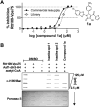Post-HTS case report and structural alert: Promiscuous 4-aroyl-1,5-disubstituted-3-hydroxy-2H-pyrrol-2-one actives verified by ALARM NMR
- PMID: 26318992
- PMCID: PMC6002837
- DOI: 10.1016/j.bmcl.2015.08.020
Post-HTS case report and structural alert: Promiscuous 4-aroyl-1,5-disubstituted-3-hydroxy-2H-pyrrol-2-one actives verified by ALARM NMR
Abstract
Despite its wide use, not every high-throughput screen (HTS) yields chemical matter suitable for drug development campaigns, and seldom are 'go/no-go' decisions in drug discovery described in detail. This case report describes the follow-up of a 4-aroyl-1,5-disubstituted-3-hydroxy-2H-pyrrol-2-one active from a cell-free HTS to identify small-molecule inhibitors of Rtt109-catalyzed histone acetylation. While this compound and structural analogs inhibited Rtt109-catalyzed histone acetylation in vitro, further work on this series was halted after several risk mitigation strategies were performed. Compounds with this chemotype had a poor structure-activity relationship, exhibited poor selectivity among other histone acetyltransferases, and tested positive in a β-lactamase counter-screen for chemical aggregates. Furthermore, ALARM NMR demonstrated compounds with this chemotype grossly perturbed the conformation of the La protein. In retrospect, this chemotype was flagged as a 'frequent hitter' in an analysis of a large corporate screening deck, yet similar compounds have been published as screening actives or chemical probes versus unrelated biological targets. This report-including the decision-making process behind the 'no-go' decision-should be informative for groups engaged in post-HTS triage and highlight the importance of considering physicochemical properties in early drug discovery.
Keywords: Chemical aggregation; Drug discovery; High-throughput screening; PAINS; Pan-assay interference compounds; Structure–activity relationships.
Copyright © 2015 Elsevier Ltd. All rights reserved.
Figures








Similar articles
-
A small molecule inhibitor of fungal histone acetyltransferase Rtt109.Bioorg Med Chem Lett. 2013 May 15;23(10):2853-9. doi: 10.1016/j.bmcl.2013.03.112. Epub 2013 Apr 4. Bioorg Med Chem Lett. 2013. PMID: 23587423 Free PMC article.
-
PAINS in the assay: chemical mechanisms of assay interference and promiscuous enzymatic inhibition observed during a sulfhydryl-scavenging HTS.J Med Chem. 2015 Mar 12;58(5):2091-113. doi: 10.1021/jm5019093. Epub 2015 Feb 21. J Med Chem. 2015. PMID: 25634295 Free PMC article.
-
A cell-free fluorometric high-throughput screen for inhibitors of Rtt109-catalyzed histone acetylation.PLoS One. 2013 Nov 18;8(11):e78877. doi: 10.1371/journal.pone.0078877. eCollection 2013. PLoS One. 2013. PMID: 24260132 Free PMC article.
-
Action plan for hit identification (APHID): KAT6A as a case study.Future Med Chem. 2020 Mar;12(5):423-437. doi: 10.4155/fmc-2019-0212. Epub 2020 Feb 17. Future Med Chem. 2020. PMID: 32064938 Review.
-
Novel trends in high-throughput screening.Curr Opin Pharmacol. 2009 Oct;9(5):580-8. doi: 10.1016/j.coph.2009.08.004. Epub 2009 Sep 21. Curr Opin Pharmacol. 2009. PMID: 19775937 Review.
Cited by
-
Assay interference and off-target liabilities of reported histone acetyltransferase inhibitors.Nat Commun. 2017 Nov 15;8(1):1527. doi: 10.1038/s41467-017-01657-3. Nat Commun. 2017. PMID: 29142305 Free PMC article.
-
Fragment screening targeting Ebola virus nucleoprotein C-terminal domain identifies lead candidates.Antiviral Res. 2020 Aug;180:104822. doi: 10.1016/j.antiviral.2020.104822. Epub 2020 May 21. Antiviral Res. 2020. PMID: 32446802 Free PMC article.
-
ALARM NMR for HTS triage and chemical probe validation.Curr Protoc Chem Biol. 2018 Mar;10(1):91-117. doi: 10.1002/cpch.35. Epub 2018 Apr 9. Curr Protoc Chem Biol. 2018. PMID: 30034947 Free PMC article.
-
Repurposing approved drugs on the pathway to novel therapies.Med Res Rev. 2020 Mar;40(2):586-605. doi: 10.1002/med.21627. Epub 2019 Aug 20. Med Res Rev. 2020. PMID: 31432544 Free PMC article. Review.
References
-
- Wipf P, Arnold D, Carter K, Dong S, Johnston PA, Sharlow E, Lazo JS, Huryn D. Curr Top Med Chem. 2009;9:1194. - PubMed
-
- Devine S, Mulcair M, Debono C, Leung E, Nissink J, Lim S, Chandrashekaran I, Vazirani M, Mohanty B, Simpson J, Baell J, Scammells P, Norton R, Scanlon M. J Med Chem. 2015;58:1205. - PubMed
-
- Han J, Zhou H, Horazdovsky B, Zhang K, Xu R, Zhang Z. Science. 2007;315:653. - PubMed
Publication types
MeSH terms
Substances
Grants and funding
LinkOut - more resources
Full Text Sources
Other Literature Sources
Molecular Biology Databases

